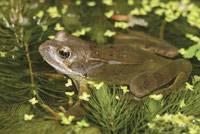Creating a Wildlife Garden - Healthy Life Essex
Home » Articles » Outdoor Life » Gardening in Essex » Wildlife Garden » Creating a Wildlife Garden
Creating a wildlife garden

There are 15 million gardens in the UK. The area they cover is more than all the National Nature Reserves in the UK. Even if your garden is very tiny, or you like your lawn and borders well manicured, there is still lots you can do to encourage wildlife into your garden. Not only will you be doing something to help wildlife survive, you will get so much additional pleasure from the birds, butterflies and other fascinating creatures you attract.
Hedgerows

Most gardens will not have enough space to plant a large hedgerow but you may have an area, perhaps at the end of the garden, where you can plant a native hedge. Why not choose bare-rooted stock, planting between December and March? They are very inexpensive and will produce excellent results. Hawthorn should be used as the mainstay of the hedge, adding perhaps wild roses, blackthorn, holly, hazel, guilder rose, rowan, elder, wild cherry and climbers such as honeysuckle. The hedge will need very little maintenance and will provide a wonderful habitat for all sorts of creatures. It will also reward you with beautiful, sweet smelling blossom in the spring, flowers throughout the summer, and bright red berries in the autumn and winter.
Fences and walls
Bare fences and walls are not very exciting, so increase the size of your garden and grow something up them! Attach a trellis or other support and grow a variety of climbers. With careful choice you will have colour throughout the year, and provide valuable food and homes for wildlife.
 Herbaceous border
Herbaceous border
Try and incorporate a wide variety of shrubs and flowers in your border, particularly if they are pollen rich. Cottage garden plants, particularly old varieties, are normally very good choices. Cornflower, evening primrose, forget-me-not, honesty, Michaelmas daisy, sunflower, wallflower, French marigold, aubretia, English bluebell, sweet violet, buddleia, heather, lavender, night-scented stock, tobacco plant, grasses and most herbs are all excellent choices.
Add some water!
 Adding water is probably one of the best ways to encourage wildlife. Even a simple bubble fountain on the patio will provide water for animals to drink and bathe. But a garden pond can be such an exciting place to see so many creatures. Make it as large as you can, but even a simple old sink is better than no pond at all. If you build your own pond, or buy a pre-cast model, try and ensure that it is shelved to provide a variety of depths, and that the sides are gently sloped to allow animals easy access. If you ensure the edges and surrounds of the pond are well planted with grasses, a bog garden or even flower beds you will have a beautiful, natural looking feature, and homes for a multitude of creatures throughout the year. Of course, if you are planning a pond you must consider the safety of any children that use the garden.
Adding water is probably one of the best ways to encourage wildlife. Even a simple bubble fountain on the patio will provide water for animals to drink and bathe. But a garden pond can be such an exciting place to see so many creatures. Make it as large as you can, but even a simple old sink is better than no pond at all. If you build your own pond, or buy a pre-cast model, try and ensure that it is shelved to provide a variety of depths, and that the sides are gently sloped to allow animals easy access. If you ensure the edges and surrounds of the pond are well planted with grasses, a bog garden or even flower beds you will have a beautiful, natural looking feature, and homes for a multitude of creatures throughout the year. Of course, if you are planning a pond you must consider the safety of any children that use the garden.
Pesticides
 If possible, please try not to use pesticides. A garden which welcomes wildlife normally has its own pest and disease control web in place. Poached egg plant, fennel, marigolds, golden rod and Michaelmas daisies all support insects that eat pests. If you encourage birds, they will eat caterpillars, leatherjackets, greenfly and snails. It may take a while to develop this ecology, but try to be patient. If spraying is really necessary, use a non-persistent pesticide.
If possible, please try not to use pesticides. A garden which welcomes wildlife normally has its own pest and disease control web in place. Poached egg plant, fennel, marigolds, golden rod and Michaelmas daisies all support insects that eat pests. If you encourage birds, they will eat caterpillars, leatherjackets, greenfly and snails. It may take a while to develop this ecology, but try to be patient. If spraying is really necessary, use a non-persistent pesticide.
Feed the birds
As your garden develops there will be many insects, fruits and berries for them to feed on. But even with a well-established wildlife garden, it may become difficult for birds to find food when the first frosts appear. Put out some extra food for them to help through those hard times. You can use any of the following:
 breadcrumbs, cooked rice or potatoes, fat and fruit
breadcrumbs, cooked rice or potatoes, fat and fruit- coconut (not desiccated)
- raisins, sultanas and currants
- mealworms
- sunflower seeds
- peanuts
And please remember:
Make sure there is always fresh water; clean feeders and bird tables regularly to ensure they do not spread disease; and peanuts in summer should always be placed in a mesh container otherwise the young could choke.
Pictures by Daniel Bridge
